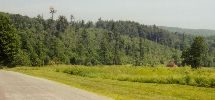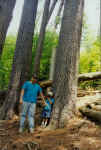| Cathedral
Pines, Cornwall, CT |
Ernie
Ostuno |
| Aug
08, 2004 20:07 PDT |
Cathedral Pines in Cornwall, CT was a 40 acre stand of primarily
white
pine and some hemlock believed to have originated from abandoned
farm or
pasture land in colonial times. In 1989 a tornado blew down all
but
about 5-10 acres of the stand. I visited this area in June 2001
and
August 2002. I was surprised to find the intact stand of old
growth
white pine and hemlock at the southern end of the original old
growth
area along a small ridge and valley (I had expected the
topography to be
flat and there to be no old trees left standing).
The white
pines were
generally 2 to 3.5 feet dbh and probably in the 120-140 foot
tall range.
The largest example of white pine I saw as far as trunk diameter
was in
a stream valley east of the ridgetop that was close to 4 foot
dbh. About
a dozen pines survived in the blowdown area, although most of
them have
limbs missing. There is a rather sharp edge to the wind damage,
which is
typical of tornadoes. I did notice evidence of the hemlock wooly
adelgid
on some hemlock saplings here. A few scattered old growth
hardwoods can
be found here, including red maple and ash.
 |
Cathedral Pines, Cornwall, CT. View looking
east at the hillside, showing the area that was hit by the
1989 tornado. Note the standing snags, and a few live
pines along with the regrowth and the dense area of old
growth at the top of the hill. Photo taken in June 2001. |
 |
View from the edge of the old growth,
showing white pine and hemlock. Note the opening in the
background along with some fallen trees and new growth.
Photo taken June 2001. |
|
|
FROM NEWSPAPER REPORTS (Yes, the liberal media):
On July 10, 1989, an area of thunderstorms first appeared in
the Berkshires of western Mass., and pushed eastward through
Massachusetts during midday. Then during mid-afternoon,
another area of squalls developed in the Berkshires. It rolled
southeastward and spun off a series of tornadoes that carved a
narrow path of destruction from Cornwall's Cathedral Pines
(one of the grandest stands of white pine and hemlock east of
the Mississippi River) to New Haven's shore. Along the path,
which seemed to follow close to Route 63, the sky darkened to
midnight proportions and the sounds of a roaring freight train
filled the air.
All but a few trees were toppled, the trunks of hundreds of
150-foot-tall pines blown over in a tangle of bark, boughs and
broken wood. It took 10 minutes to destroy a 200-year-old
forest.
The strongest tornado in the cluster touched down in Hamden
and New Haven. The intensity could match anything the Midwest
might be able to deliver. Estimated winds were in the 200 mph
category. The only fatality I know of was a Girl Scout at a
state park about halfway between Cornwall and New Haven, hit
by a tree or limb.
|
|